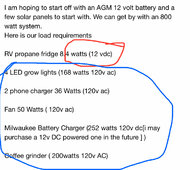Luismclaughlin
New Member
I was originally looking at an EG4 charge controler /inverter combo and going with EG4 3000EHV-48 ad 2. 48v batteries. Then I realized that I didn’t have the money for it. I am now looking at the Victron SmartSolar MPPT 150/100-Tr VE.Can
I am hoping to start off with an AGM 12 volt battery and a few solar panels to start with. We can get by with an 800 watt system.
Here is our load requirements
RV propane fridge 8.4 watts (12 vdc)
4 LED grow lights (168 watts 120v ac)
2 phone charger 36 Watts (120v ac)
Fan 50 Watts ( 120v ac)
Milwaukee Battery Charger (252 watts 120v dc[i may purchase a 12v DC powered one in the future ] )
Coffee grinder ( 200watts 120v AC)
Down the road we plan to add enough capacity for running a washer 4 to 6 loads a week plus several other electric powered devices. That system will probably require anywhere from 3000 to 6000 watts. I would like to purchase a system at the beginning here, where I don’t have to get rid of it and buy something else to upgrade. Will the Victron unit I mentioned work so that I can add to it later? And then change the batteries from lead acid batteries to lithium 48V? We have around $1,300 to work with right now.
I am hoping to start off with an AGM 12 volt battery and a few solar panels to start with. We can get by with an 800 watt system.
Here is our load requirements
RV propane fridge 8.4 watts (12 vdc)
4 LED grow lights (168 watts 120v ac)
2 phone charger 36 Watts (120v ac)
Fan 50 Watts ( 120v ac)
Milwaukee Battery Charger (252 watts 120v dc[i may purchase a 12v DC powered one in the future ] )
Coffee grinder ( 200watts 120v AC)
Down the road we plan to add enough capacity for running a washer 4 to 6 loads a week plus several other electric powered devices. That system will probably require anywhere from 3000 to 6000 watts. I would like to purchase a system at the beginning here, where I don’t have to get rid of it and buy something else to upgrade. Will the Victron unit I mentioned work so that I can add to it later? And then change the batteries from lead acid batteries to lithium 48V? We have around $1,300 to work with right now.





